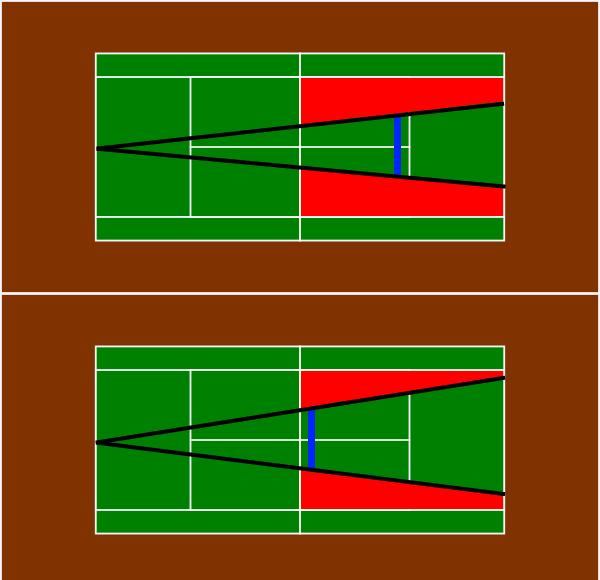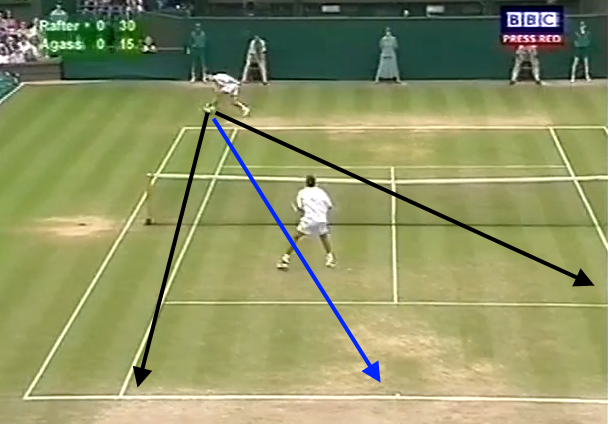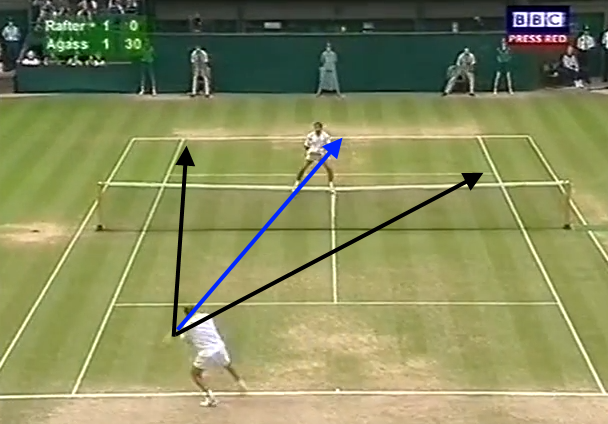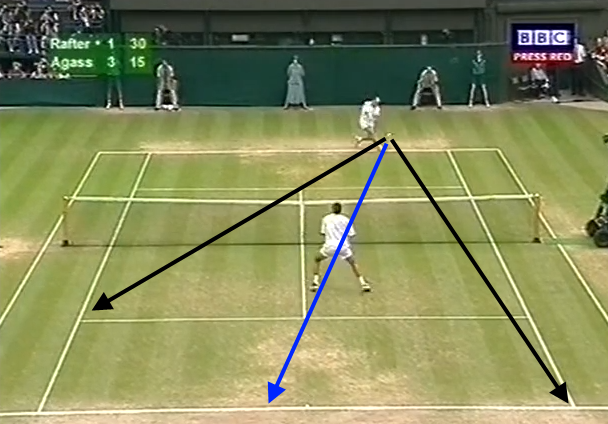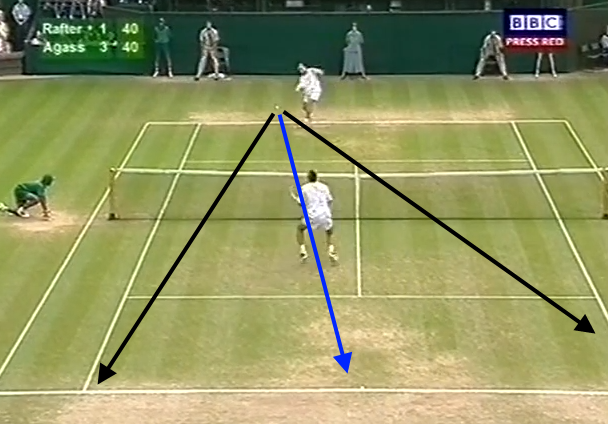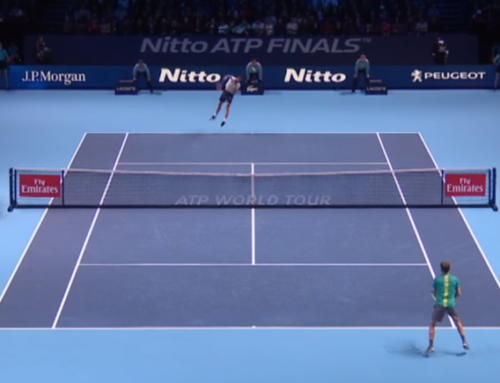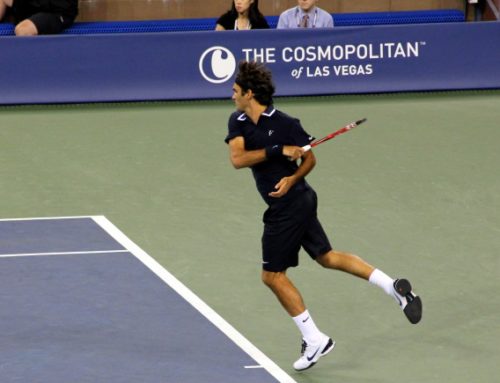As Wimbledon begins tomorrow it seemed an appropriate time to tackle an issue I run into frequently on court with my clients. As their groundstrokes begin to improve dramatically, they find themselves earning more and more short balls off which they have little choice but to come to the net behind. And once arriving, they have little idea where to stand and find themselves getting passed or lobbed consistently. This is a common problem, not just at the recreational level but also in college play and even for the pros. Proper net positioning has become something of a dying art as the number of net approaches has dwindled in the past decade. So today in Part 4 of our “Building A Singles Game Plan, we will examine just that: where should you stand at the net and why?
The Importance Of Closing
In reality, positioning at the net is important in two dimensions. Oftentimes players focus too much on the lateral positioning (ie where they stand between the two sidelines) and neglect perhaps the single easiest way to impact their net play – their vertical positioning. By vertical we are referring to their front-to-back positioning between the service line and the net. The single most glaring problem I see over and over again is a failure on the part of the would-be net player to close. Instead, they tend to hit their approach shot and grind to a halt somewhere one or two steps inside the service line, letting their fear of the lob, being hit or just generally defensive-mindedness dictate their position. This is, in fact, the single worst thing a player could do, and in truth they are almost guaranteeing they will lose the point. Instead once the decision to to go forward is made we must commit to get as close to the net as reasonably possible for each and every volley. Here is why:
The blue bar in the pictures above represent the one-step reach of the net player upon approaching the net – that is to say the lateral space he or she can cover with a single step. The red area represents the portion of the court not covered by the net player. Noting that the blue bar is the same size in both images, we can see that the red space is significantly smaller in the second image. Just how much of a difference does this make? Let’s put some numbers to it!
Let’s start with a 6′ player at the net, and assume rather cautiously that he can cover 7′ to either side (2′ step, 3′ arm length, and 2′ racket length). If this player were to stand 2 feet inside the service line, he would be able to cover 550 square feet of the court space on his side of the net in that one step. While that may seem like a lot, if that same player were to move to 3 feet from the net instead, he would cover 760 square feet of court space! Considering that there is 1053 square feet of space in the singles court, in the first instance, not closing, the player leaves 503 square feet uncovered. In the second instance, by closing, the player leaves only 293 square feet uncovered. That’s shrinking his opponent’s possible passing shot space by almost half!
So while it seems not to be intuitive to most people, hanging back when approaching the net does not allow for better defense. The closer you get to the net, the less space you allow your opponent to hit a passing shot. Additionally the closer you get to the net the easier your volleys become. Two feet inside the service line it is easy to hit a ball at your feet. Stand three feet from the net and it becomes impossible. Indeed get close enough, and even the worst-struck volley will still make it over. Closer to the net you have access to more angles, and can hit the ball softer and still get it over.
Take Away The Easiest Shots
“Follow the ball” is a mantra I’ve heard used many times by coaches when teaching their students. But exactly how far should one go? “Get in front of the ball” is another popular phrase, but your goal is really very simple: to take away the easiest shots from your opponent. Hitting passing shots can be difficult business. The pressure is on, putting just another ball in play is no longer an option. The single best thing we can at this juncture of the point as the net player is to take away the easiest shots. How do we do that?
It’s really quite simple. Take the possible angles your opponent can hit, and stand smack-bang in the middle of them (otherwise known as bisecting the possible angles of return). Before you go scrambling for your protractor, calculator and trigonometry textbooks, rest easy. Rather than rely on you to do math on the fly, we’re going to take a look at some correct net positions, and let you copy them instead.
I thought it best to provide some examples, and could find no better than the net positioning of my fellow Australian Pat Rafter. Rafter knows a thing or two about net coverage, having serve and volleyed his way to two US Open titles and two Wimbledon finals. And, if I was going to pick a match to watch in order to find suitable examples, what better than the Wimbledon Semi-final between Pat Rafter and Andre Agassi in 2001. So where does Pat Rafter stand when he comes to the net?
We can see here in the picture that the black arrows indicate roughly the two opposite extremes of angle that Agassi can possible hit his passing shot into. The blue line represents the approximate bisection of the angle, and as we can see Rafter is standing smack-dab on the blue line. In doing so, he takes away the easiest shots. Of all the possible places Agassi can hit the ball, he is now forced to hit away from the center of his options, and as far towards the edges (and hence out) as Rafter can make him.
Here is another example, off an Agassi backhand passing shot this time. Note again that Rafter is right on the blue line, and is balanced, his hips and shoulders square to the net.
And then one final example…
One thing to understand about the driving idea here is that it is affected by your opponent’s capabilities. Those black arrows will point at different places on the court depending on your opponent. Federer’s possibilities for the pass are far wider apart than the average 5.0 player. Additionally, if your opponent has a particular weakness than you can take advantage of that. If they are unable to hit a backhand consistently cross-court, you can shift that arrow appropriately and then your blue line moves as a result. This isn’t about covering the possibilities that anyone can hit off the passing shot, it’s about what your opponent can hit.
Conclusion
“Bisect the angles of possible return” isn’t as easy to remember as “follow the ball” or “get in front of the ball”. It is more correct than either of those relatively vague pieces of advice. Another way to think of it is simply by standing in the middle of what your opponent can possibly hit for a passing shot (says exactly the same thing but much less ‘mathy’). The next time you come to the net, keep this in mind. Don’t run to the center of the court, and don’t go and stand in front of the ball (unless, that is, you hit the ball right up the middle of the court!). Instead, shift towards the ball enough that you take away their best options and leave them with the toughest shots you can and close the net. It won’t win you every point, but it will improve your net play and win you more points than the alternative.
